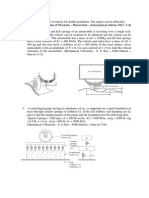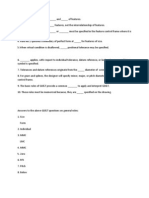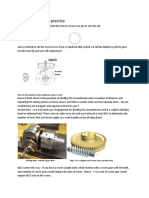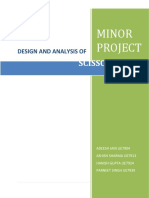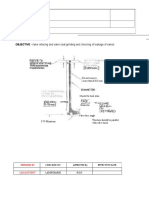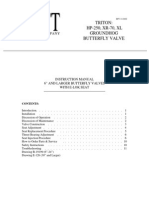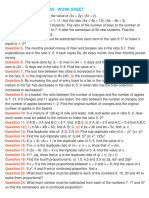Refacing Valves and Valve Stems
Refacing Valves and Valve Stems
Uploaded by
HaftayCopyright:
Available Formats
Refacing Valves and Valve Stems
Refacing Valves and Valve Stems
Uploaded by
HaftayOriginal Title
Copyright
Available Formats
Share this document
Did you find this document useful?
Is this content inappropriate?
Copyright:
Available Formats
Refacing Valves and Valve Stems
Refacing Valves and Valve Stems
Uploaded by
HaftayCopyright:
Available Formats
REFACING VALVES AND VALVE STEMS
Once it has been determined that valves are serviceable, they are refaced in specialized valve
grinders. All pits must be removed in grinding, because any that remain will cause hot spots on
the valve face and burning will result. The burning occurs because heat cannot transfer from
the valve through the seat without contact at points where pitting remains. The surface finish
quality is also as fine as can be obtained to ensure full contact on the valve seat. The grinding
wheel must be dressed frequently. And a flow of clean grinding oil is directed between the
grinding wheel and the valve face to obtain the required surface quality.
Valve seat angles are approximately 450 however, valves are typical to provide a slight
interference angle between the valve and seat. The interference angle provides for a narrow
line of contact when the valve first contacts the seat. Manufactures often specify 450for the
valve face angle and a larger angle for the valve seat to provide a 1/20 to 20 interference angle.
Warped or bent valves are easily detected during re facing. A warped valve will clean
up on one side only. Discard these valves and don’t attempt to grind them to a clean-up.
The tips of the valve stems must also be refaced. Check the chamfer (the bevel on the
edge) first and regrind it to approximately 0.7mm wide .This amount should keep a sharp edge
from forming after re facing the stem.
Grinding Valve Seats
It is absolutely essential that valve guides be in good condition before seat grinding because
seat grinding stones are guided by a pilot in the valve guide. The pilot can not properly locate
in badly worn valve guides. Incorrect location of the pilot will cause the valve seat to be
ground off center or at an angle to the valve guide.
The object of valve seat grinding is to obtain a valve seat with the correct width and
uniform width all around. The valve seat must also be located in the correct position on the
valve face. High- speed drive motors are used to obtain high-quality valve seat finishes
Valve seat width is critical. Too wide a valve seat tends to trap carbon and cause
burning: too narrow a valve seat does not transfer sufficient heat and, therefore, causes
burning.
CUTTING VALVE SEATS
Valve seats may be restored to new condition by cutting instead of grinding. Typically,
cutters are mounted in holders. The angle in the holder is fixed but the diameter is adjustable.
Unlike grinding, it is recommended that the 450(or 300) seat angle be cut last so that the
width of cut may be narrowed, which will make it easier to obtain good seat finishes. The
cutter is used over a pilot, as with a grinding stone and may be used by hand or with low speed
drive motor.
Lapping valves and valve seat
After the valve have been refaced and seats ground, then the valve and seat can be lapped to
each other. The lapping of valves and seat is done by placing abrasive compound between the
valve face and seat and turning the valve back and fourth. Lapping is required to obtain a
suitable valve seat finish on seats that are difficult to machine, and it is even recommended by
some manufacturers. If lapping is to be done it is recommended here that the seats be lapped
with an old valve that has been refaced. In this way, the seat finish can be improved with out
undercutting on the faces of the valve to be installed in the engine.
Valve seat inserts
Valve seat inserts are used to replace original equipment inserts that are no longer serviceable.
They are also installed in cylinder heads having integral valve seats. The integral valve seat
may be worn beyond service limit, or seat inserts may be installed as part of a crack repair
(cracks frequently extend across valve seats).
Valve seat inserts are available as replacements for original inserts or for repairing cylinder
heads with integral seats. The inserts are selected by size (dimension) and materials. The
dimensions used are outside diameter, inside diameter and depth. The available materials are
cast iron, hardened cast iron and high nickel chrome alloys.
The procedure for repairing a cylinder head with original seat inserts begins with
1. Removing non serviceable seats
2. Once the valve seat is removed, inspect the bore in the head for damage and then
measure the inside diameter. Compare the inside diameter of the bore to out side
diameter of the replacement seats. The difference in diameters should be with in the
range of specified interference given in specification.
3. Select the insert and its matching cutter from the data list in the makers guide catalogue.
4. Select the cutter pilot that fits the valve guide. Install the pilot in the guide, place the
cutter over the pilot and engage the machine spindle to the cutter. Set the depth stop to
the thickness of the seat inserts.
5. The finished bore is cleaned and lubricated so that the seat may now be driven in to
place.
Re facing Rocker arm
Rocker arm wear on the surface in contact with the valve stem in many cases can be refaced
easily and quickly on a valve grinder.
Check the clearance between the rocker arm and rocker shaft before going ahead with the
re facing machine. Some times the clearance is excessive and both rocker arm bores and the
shaft are worn. It is recommended that rocker arms be salvaged only if clearance is
acceptable or can be restored to specification by replacing the shaft. Excessive clearance
between the rocker arm and shaft may cause a reduction in oil pressure and should be
corrected.
Replacing rocker arm studs
Rocker arms that are cut on the side should be replaced to maintain. The same is true for
rocker arm studs that are being pulled out of the cylinder head by valve spring and cam
action against rocker arms.
Replacement studs are available in 0.076 mm or larger over sizes. The stud bore must be
reamed oversize for replacement studs. An interference fit of 0.03 to 0.05 mm is maintained.
Correcting Installed Spring Height
After re facing valves and grinding valve seats, the valve moves through the cylinder head to a
greater depth. The length of valve spring is also extended. It is essential that valve spring
installed height be restored to original specification so the specified spring height can be
attained.
Installed spring height can be corrected by placing shims under the valve springs. The
installed height first must be measured to determine the thickness of shims required. Keep in
mind that aluminum cylinder head has already had a steel shim under the spring to prevent
damage to the softer surface of the cylinder head. Keep this original shim in place when
measuring installed height.
It is most important to realize that shims are used to restore spring installed height to
specification, not to increase spring tension. Don’t shim below installed height specification.
Spring failure can result because of added load on the springs. Compression of valves during
valve opening will bend push rods and flatten the camshaft.
Correcting Installed stem height
First, valve stem installed height should not be confused with spring installed height. Valve
stem installed height is measured from the spring seat to the tip of the valve stem and is critical
on engines with non adjustable rocker arms. The height increases as a result of valve grinding
procedure and can cause hydraulic valve lifters to hold the valves to open.
It is measured by placing valves at each end of the cylinder heads. The height on these
valves can be corrected by facing the stems on the valve grinder. A straight edge may then be
placed across two end valves and each of the remaining valves can be faced until it aligns with
the straight edge.
Regrinding camshaft and lifter
If it has been determined that the camshaft is worn beyond usable limits, the shaft must be
replaced or salvaged by regrinding. Before regrinding, camshaft lobes are inspected to
determine the extent of wear. If badly worn, individual cam lobes may be built up by welding.
Fuel pump eccentric and distributor drive gears must also be checked. A fuel pump eccentric
can be built up by welding, but if the distributor drive gear is worn, the cam shaft is scrapped.
The regrinding process is begun by checking the camshaft for straightness and straightening
it as required. Each cam lobe is then reground, usually to original equipment specifications for
lift and duration. Reduction of base circle diameter during regrinding should be limited,
especially on non adjustable value trains or noise may result
As mentioned, camshafts are usually ground to original equipment specifications. One
common question is, “How is specified lift maintained?” Keep in mind that each cam lobe is
ground its full circumference. Lift is also determined by the difference in the distance from the
nose of the cam lobe to the heel (on the base circle) and the base circle diameter. The same
after grinding. To increase lift on performance camshafts, more is ground from the base circle.
You might also like
- Sae J670 2008 PDFDocument73 pagesSae J670 2008 PDFJoão Ferro100% (3)
- Exam Car Body Repair, Theory With AnswersDocument2 pagesExam Car Body Repair, Theory With AnswersHaftay100% (8)
- Statement of PurposeDocument2 pagesStatement of Purposearifsalman5120% (1)
- Swivel JointsDocument102 pagesSwivel JointsAliNo ratings yet
- Assignment 2 2dofDocument4 pagesAssignment 2 2dofAnonymous C1A51gvTwNo ratings yet
- Designing A StaplerDocument41 pagesDesigning A StaplerEmmanuel Morales ChilacaNo ratings yet
- Course Outline Automatic TransmissionDocument2 pagesCourse Outline Automatic TransmissionHaftayNo ratings yet
- Design of RivetsDocument20 pagesDesign of RivetsRavishanker BaligaNo ratings yet
- SOM-Skill Course-1Document81 pagesSOM-Skill Course-1Rohit RanjanNo ratings yet
- M06-031 - Basic Fundamentals of Gear DrivesDocument79 pagesM06-031 - Basic Fundamentals of Gear DrivesjadewestNo ratings yet
- Statically Indeterminate Structures (Statics)Document2 pagesStatically Indeterminate Structures (Statics)cowboys20No ratings yet
- Fluid Mechanics (BTME-301-18)Document13 pagesFluid Mechanics (BTME-301-18)Surjit Kumar GandhiNo ratings yet
- Architecture: Assosa UniversityDocument48 pagesArchitecture: Assosa UniversityAbenezer GetachewNo ratings yet
- Strength of Materials/Mechanics of Solids (CE-303/DCE-303) - Short Answer Questions-UIT-RGPV BHOPALDocument4 pagesStrength of Materials/Mechanics of Solids (CE-303/DCE-303) - Short Answer Questions-UIT-RGPV BHOPALSantosh Kumar0% (1)
- Pro-E GD&TDocument7 pagesPro-E GD&TVjaddictedNo ratings yet
- DrawingDocument8 pagesDrawingTommyVercettiNo ratings yet
- Question Bank III B.Tech-II Sem Design of Machine Members-Ii Unit - I A Design of Curved Beams Short Answer QuestionsDocument11 pagesQuestion Bank III B.Tech-II Sem Design of Machine Members-Ii Unit - I A Design of Curved Beams Short Answer Questionsprasaad08No ratings yet
- NEA PrepationDocument21 pagesNEA Prepationaziz100% (1)
- DSR Unit 1Document69 pagesDSR Unit 1hujefaNo ratings yet
- Gear Cutting by Differential Indexing On Milling Machine Workshop Practice IIDocument6 pagesGear Cutting by Differential Indexing On Milling Machine Workshop Practice IIPartho RoychoudhuryNo ratings yet
- 9.me3681 Cad - Cam Lab Question 1Document22 pages9.me3681 Cad - Cam Lab Question 1Divya PriyaNo ratings yet
- 1st Seminar of Sheet Metal Bending MachineDocument22 pages1st Seminar of Sheet Metal Bending MachineMyo MinNo ratings yet
- Artificial Oxygen Tree ReportDocument58 pagesArtificial Oxygen Tree ReportvivekNo ratings yet
- Topic:-Design Analysis of Curved Beam,: Crank Hook and C ClampDocument11 pagesTopic:-Design Analysis of Curved Beam,: Crank Hook and C ClampKartik YadavNo ratings yet
- Construction TechnologyDocument78 pagesConstruction TechnologyAldina MuthoniNo ratings yet
- Literature Review of Leaf SpringDocument3 pagesLiterature Review of Leaf Springneeraja manem100% (1)
- On Coupling, Clutches, BrakesDocument23 pagesOn Coupling, Clutches, BrakesSubhajyoti GangulyNo ratings yet
- Jig DesignDocument23 pagesJig DesignЦырен ЖалсаповNo ratings yet
- Machine Design Project Lecture - 2Document115 pagesMachine Design Project Lecture - 2Hinsermu NeftalemNo ratings yet
- Naseel Ibnu Azeez.M.P Assistant Professor Department of Mechanical EngineeringDocument23 pagesNaseel Ibnu Azeez.M.P Assistant Professor Department of Mechanical Engineeringrahul singh100% (1)
- 15ME3112 Design of Machine ElementsDocument29 pages15ME3112 Design of Machine Elementslikhith saiNo ratings yet
- Worked Examples - Journal & Roller Bearing DesignDocument2 pagesWorked Examples - Journal & Roller Bearing Designsbusiso100% (1)
- U-2 Mechanical Working of MetalsDocument76 pagesU-2 Mechanical Working of Metalsapi-271354682No ratings yet
- 962 PDFDocument36 pages962 PDFdipNo ratings yet
- Solid Ground CuringDocument10 pagesSolid Ground CuringAkshay Hejjaji100% (2)
- Stuctural Analysis Using AnsysDocument39 pagesStuctural Analysis Using AnsysVishnuPrasadNo ratings yet
- Advance Welding - Syllabus (KME-055)Document3 pagesAdvance Welding - Syllabus (KME-055)Shashank DwivediNo ratings yet
- Emission Control SystemsDocument44 pagesEmission Control SystemsNilesh MeghwalNo ratings yet
- Project Report On Composite Sleepers (17102023) - Maam CorrectionDocument44 pagesProject Report On Composite Sleepers (17102023) - Maam Correctionsmitirupa.pradhanfmeNo ratings yet
- Bahir Dar University Bahir Dar Institute of Technology Faculity of Mechanical and Industrial Engineering Industrial Engineering DepartmentDocument13 pagesBahir Dar University Bahir Dar Institute of Technology Faculity of Mechanical and Industrial Engineering Industrial Engineering DepartmentTamr KasayeNo ratings yet
- Design of Machine Elements Unit 5Document119 pagesDesign of Machine Elements Unit 5Sathis KumarNo ratings yet
- Report Screw Jack (1) TDocument47 pagesReport Screw Jack (1) TAshish Sharma80% (5)
- Unit-I - Limit State Method Concept and Design of Beams: 1. MaterialsDocument7 pagesUnit-I - Limit State Method Concept and Design of Beams: 1. MaterialsYAZHININo ratings yet
- Study On The Performance of Electroless Nickel Coating On Aluminium For Cylinder LinersDocument8 pagesStudy On The Performance of Electroless Nickel Coating On Aluminium For Cylinder LinersBharat Vinjamuri100% (1)
- Failures Modes of Riveted JointsDocument5 pagesFailures Modes of Riveted JointsGokul Goku SanthiNo ratings yet
- RivetDocument20 pagesRivetgurdyalNo ratings yet
- Study of Plain Plug Gauge: Mini ProjectDocument19 pagesStudy of Plain Plug Gauge: Mini ProjectdomiNo ratings yet
- Lecture 6 Design of The Crankshaft: ResearchDocument22 pagesLecture 6 Design of The Crankshaft: Researchsujay nayak0% (1)
- Vtupulse.C: Module-5 Contract Management Post AwardDocument49 pagesVtupulse.C: Module-5 Contract Management Post AwardNayim InamdarNo ratings yet
- Fitting: Files Without This Message by Purchasing Novapdf PrinterDocument14 pagesFitting: Files Without This Message by Purchasing Novapdf PrinterWilliams A.Subanth Assistant ProfessorNo ratings yet
- Scotch Yoke MechanismDocument36 pagesScotch Yoke MechanismAnil Kumar83% (6)
- ME8651qb Design of Transmission SystemsDocument18 pagesME8651qb Design of Transmission SystemsMURALI KRISHNAN RNo ratings yet
- Double Wishbone SuspensionDocument5 pagesDouble Wishbone SuspensionalexmarieiNo ratings yet
- Spindle DeflectionDocument8 pagesSpindle DeflectionFabrizio GrassoNo ratings yet
- Chapter 6 Ribbed Slab and Waffle SlabDocument15 pagesChapter 6 Ribbed Slab and Waffle Slaba20082909No ratings yet
- RivetingDocument32 pagesRivetingJOYCE ONYEAGORO100% (1)
- Paper On Design and Analysis of Wheel Set Assembly & Disassembly Hydraulic Press MachineDocument4 pagesPaper On Design and Analysis of Wheel Set Assembly & Disassembly Hydraulic Press MachineEditor IJRITCCNo ratings yet
- Riveted JointsDocument44 pagesRiveted Jointssharwan sharma67% (3)
- DSS MCQ SSJDocument5 pagesDSS MCQ SSJsurendranath jadhav100% (1)
- Valve Reconditioning ProcedureDocument3 pagesValve Reconditioning ProcedureScribdTranslationsNo ratings yet
- Lab Manual: Department of Mechanical EngineeringDocument46 pagesLab Manual: Department of Mechanical EngineeringsrknotesNo ratings yet
- Valve Refacing and Valve Seat Grinding and Checking of Leakage of ValvesDocument6 pagesValve Refacing and Valve Seat Grinding and Checking of Leakage of ValvesNandakumar BasavarajNo ratings yet
- Pratt - Bfv-14 Triton XR, XL, Hp-250Document14 pagesPratt - Bfv-14 Triton XR, XL, Hp-250tiago_mozartNo ratings yet
- Bearing Installation ProcedureDocument6 pagesBearing Installation ProcedureHamad KhaledNo ratings yet
- Crack Detection & RepairDocument5 pagesCrack Detection & RepairHaftay100% (1)
- Air Conditioning System Compressor Removal LabDocument1 pageAir Conditioning System Compressor Removal LabHaftayNo ratings yet
- Ethiopia - Injera - May - 17 - 2010 - FINAL - Report1 (1) DAVE SUD 2007Document73 pagesEthiopia - Injera - May - 17 - 2010 - FINAL - Report1 (1) DAVE SUD 2007Haftay100% (1)
- Laboratory Guide Automatic TransmissionDocument18 pagesLaboratory Guide Automatic TransmissionHaftayNo ratings yet
- Integrated Chassis Control System For Improving Vehicle StabilityDocument5 pagesIntegrated Chassis Control System For Improving Vehicle StabilityHaftayNo ratings yet
- Instant Ebooks Textbook Fundamentals of Physics Extended 10th Edition David Halliday Download All ChaptersDocument60 pagesInstant Ebooks Textbook Fundamentals of Physics Extended 10th Edition David Halliday Download All Chapterstiouaxanday100% (7)
- Novatec Premium Ii: Technical Data SheetDocument1 pageNovatec Premium Ii: Technical Data SheetRuben PauwelsNo ratings yet
- Ceramic Matrix Composites in The Design and Development of Convergent-Divergent Nozzle ComponentsDocument10 pagesCeramic Matrix Composites in The Design and Development of Convergent-Divergent Nozzle ComponentsRajeshKumarSahuNo ratings yet
- 77 170 2012 PDFDocument15 pages77 170 2012 PDFsathi11189No ratings yet
- Generator Room Ventilation 1Document3 pagesGenerator Room Ventilation 1Pradeep SukumaranNo ratings yet
- Instruction - VCC 346367 1Document9 pagesInstruction - VCC 346367 1arwid vasilevNo ratings yet
- Hidral Uh DiagramasDocument4 pagesHidral Uh DiagramasSaul Castillo100% (2)
- ProblemsDocument4 pagesProblemsmarslanjameelmalikNo ratings yet
- Design Data Handbook ( (MD-I)Document32 pagesDesign Data Handbook ( (MD-I)satyamchgl2010No ratings yet
- RR Rto-14813Document48 pagesRR Rto-14813gestada023No ratings yet
- R.P WorksheetDocument3 pagesR.P WorksheetSashankNo ratings yet
- Saadon 2016 IOP Conf. Ser. Mater. Sci. Eng. 152 012011Document9 pagesSaadon 2016 IOP Conf. Ser. Mater. Sci. Eng. 152 012011Victor BettNo ratings yet
- Numerical Investigation On The Effect of Injection Timing On Combustion and Emissions in A Di Diesel Engine at Low Temperature Combustion ConditionsDocument15 pagesNumerical Investigation On The Effect of Injection Timing On Combustion and Emissions in A Di Diesel Engine at Low Temperature Combustion ConditionsErick DominguezNo ratings yet
- Design of Portal Frame - 3Document38 pagesDesign of Portal Frame - 3afn3178No ratings yet
- Ninja400 Uses Manual 1Document28 pagesNinja400 Uses Manual 1njkawasakiNo ratings yet
- Apollo Instruction ManualDocument14 pagesApollo Instruction ManualAndrew Mazurkiewicz100% (1)
- Engineering MechanicsDocument23 pagesEngineering MechanicsBhavesh Shrimali100% (2)
- Beam Deflection Second-Order MethodDocument11 pagesBeam Deflection Second-Order Methodmiry89No ratings yet
- Micro Hardness Testing Machines: IndexDocument28 pagesMicro Hardness Testing Machines: IndexAlan GonzalezNo ratings yet
- Geotechnical Engineering RCE-501 2018-19Document2 pagesGeotechnical Engineering RCE-501 2018-19Akeel JavidNo ratings yet
- 267720312-QP 6103 Pipe Fitter (Oil & Gas) Kaushal MartDocument20 pages267720312-QP 6103 Pipe Fitter (Oil & Gas) Kaushal MartAladin ZeribiNo ratings yet
- Alternators Letrika Web 1Document28 pagesAlternators Letrika Web 1ahmed nourNo ratings yet
- Differential Pressure Switch Weather Proof Diaphragm TypeDocument3 pagesDifferential Pressure Switch Weather Proof Diaphragm TypeJeneshNo ratings yet
- Finite Element MethodsDocument2 pagesFinite Element MethodsRadha KrishnaNo ratings yet
- ADVANCEDBeam ManualCompositeDocument28 pagesADVANCEDBeam ManualCompositeAmir ShaikNo ratings yet
- ECOMax-HE - Installation Guidlines - RDocument6 pagesECOMax-HE - Installation Guidlines - Rvishaldeep1991_44539No ratings yet
- Initiation and Arrest of An Interfacial Crack in A Four-Point Bend TestDocument18 pagesInitiation and Arrest of An Interfacial Crack in A Four-Point Bend TestRaul MamaniNo ratings yet




